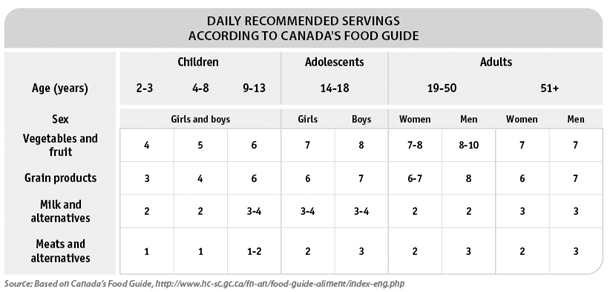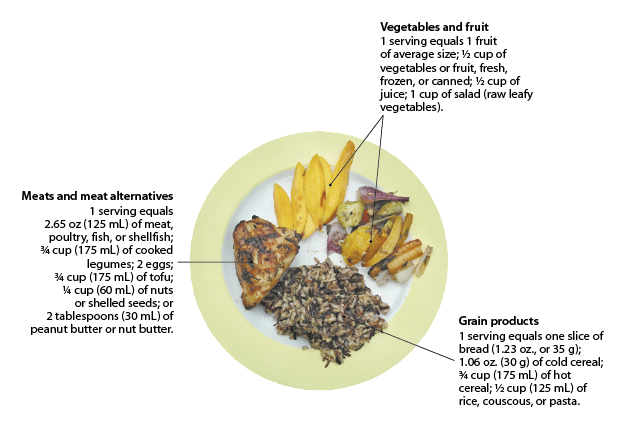A balanced diet
A balanced diet provides all of the nutrients (Carbohydrates, proteins, fats, minerals, vitamins, water) and energy the body needs, on a daily basis, without deficiency or excess. The daily recommended energy needed for an average adult is approximately 2,000 to 2,500 calories (or kilocalories) for a man and 1,800 to 2,000 calories (or kilocalories) for a woman. However, needs vary according to age, height, weight, profession, physical activity, and certain circumstances (pregnancy, nursing, disease). The diet must be adapted in the cases of high blood pressure, diabetes, dietary intolerances, or other specific conditions.
Calories, energy of the body
The calorie (cal) is a unit of measurement of energy that is absorbed in the form of food or used by the body. In nutrition, we primarily use its multiple, the kilocalorie (kcal) or Calorie (Cal), equal to 1,000 calories. Food labels sometimes use another unit, the joule (J), with the equivalence: 1 kcal = 4.1855 kJ.
Recommendations of the Food Guide
The various nutrients (carbohydrates, proteins, fats, minerals, vitamins) are distributed in four major food groups: grain products, vegetables and fruit, milk and milk alternatives, and meat and meat alternatives. The Food Guide specifies the daily recommended portions for each of these groups. The guidelines vary slightly from one country to another (e.g. with regard to recommended portions), but the order of importance of each group remains the same. Thus, eating large quantities of grain products, vegetables and fruit is recommended. Dairy products and meats are to be consumed more moderately. Finally, the recommended servings vary according to age, height, sex, weight, and level of physical activity.


Energy needs of a pregnant or nursing woman
The energy needs of a pregnant or nursing woman are much greater. In Canada, for example, the Food Guide recommends having two to three additional servings from any of the food groups daily. In order to prevent fetal anomalies and anemia, it is also recommended they take a daily vitamin supplement containing folic acid and iron.
Rules for a healthy diet
Even though many foods present a detailed nutritional label, it is useless to attempt to perfectly control the quantities of various nutrients absorbed daily. Observing the recommendations of the dietary guide for the four main food groups and following a few golden rules is sufficient.
Have three main meals a day and complement them with one or two snacks.
Eat fruit, vegetables, and whole grain cereal products with each meal. They are an excellent source of vitamins, minerals, fiber, and antioxidants.
Nuts and grains are excellent. They are sources of protein, good lipids (unsaturated fats), and antioxidants.
Limit fats, particularly those that are used for cooking and seasonings and those that are hidden in baked goods, crusts, processed meat products, etc.
Steam vegetables and cook meat and fish on a grill, in an oven, on the stove, etc., adding little or no oil. Avoid frying.
Use olive oil and canola oil. They contain good lipids.
Limit sugars, baked goods, carbonated soft drinks, etc.
Drink plenty of water, at least 6–8 cups (1.5–2 liters) per day, and reduce your alcohol consumption, if necessary.
Reduce your salt consumption. Season your food with spices and fines herbes and limit your consumption of commercially processed foods.
Control your diet by reducing the number of meals eaten in restaurants and the purchase of prepared meals (which often contain too much sugar, salt, or fat).
Take the time to savor food and enjoy meal hours. Eat a wide range of foods in moderation.
Food labeling
The labeling on packaged foods provides information on the nutritional value of their contents. The first line of a label indicates the serving size of the nutritional data. To compare two different brands, you must compare identical servings. The quantity of calories and content of various nutrients in this serving are then listed. The quantities are generally given in milligrams (mg) or grams (g), and in a percentage of a daily recommended value. When the percentage of a nutritious element is below 5%, its dietary contribution is considered to be low. Above 20%, it is high. Choose products that are low in sugar, sodium (salt), and saturated and trans fats.





